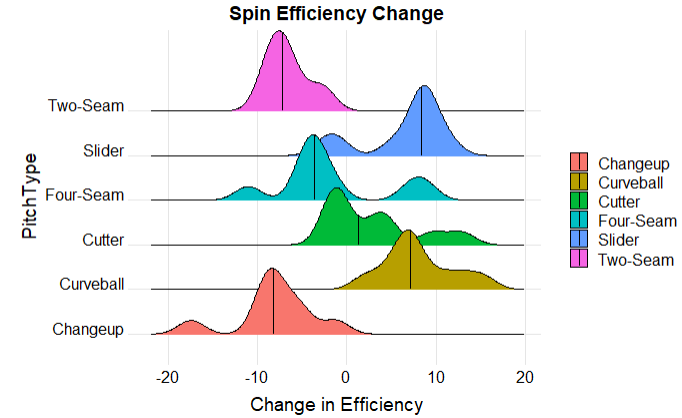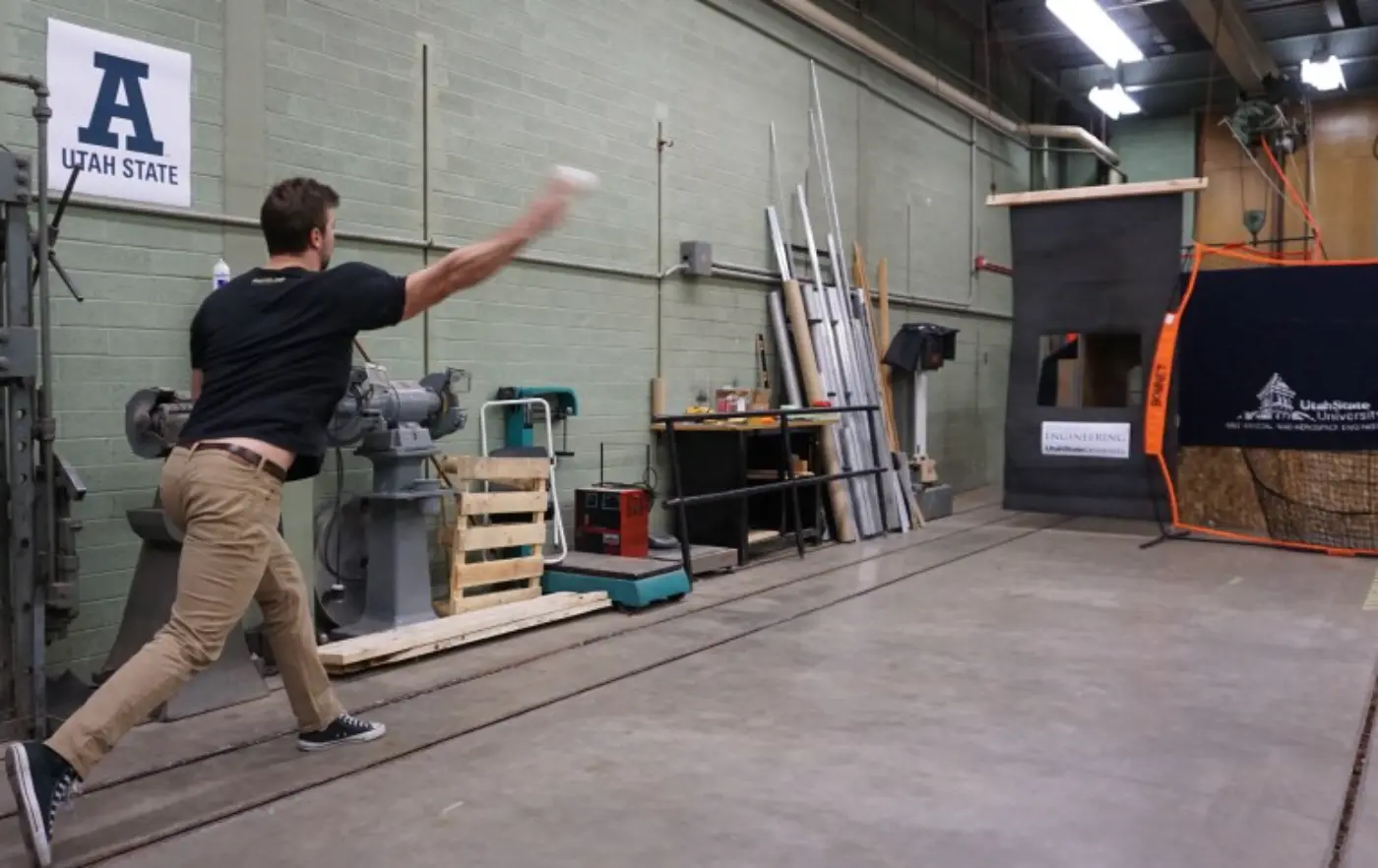What movement pitch was she throwing (or was she?) and did she have a change up?I watched a D3 pitcher shutdown my daughter's team yesterday. She didn't break 56 MPH, but she struck out 16 batters, 12 of them 1 2 3. She gave up one hit and no walks, and she threw 76 pitches, 67 for strikes. She didn't need the speed to keep them off balance. In their defense, they haven't hit well in their first four games, but it was still impressive and disturbing to watch. I have to think she'd get hammered at the D1 level, though.
You are using an out of date browser. It may not display this or other websites correctly.
You should upgrade or use an alternative browser.
You should upgrade or use an alternative browser.
Spin rate and Velocity
- Thread starter tomorrow
- Start date
So what was her magic formula, a spin pitch, or something else that baffled the hitters? I accompanied a D3 team for spring training last year and we faced a pitcher with a genuine riseball, about 75% back spin. She no hit us and the coach told us that we were her 3rd no hitter that spring. She maxed out at about 52. She threw that rise on just about every pitch. She started out throwing it low in the zone and everyone was taking it for a lot of called strikes. When we started to adjust she began throwing it up in the zone for a lot of swing and misses.I watched a D3 pitcher shutdown my daughter's team yesterday. She didn't break 56 MPH, but she struck out 16 batters, 12 of them 1 2 3. She gave up one hit and no walks, and she threw 76 pitches, 67 for strikes. She didn't need the speed to keep them off balance. In their defense, they haven't hit well in their first four games, but it was still impressive and disturbing to watch. I have to think she'd get hammered at the D1 level, though.
It was a lot of balls up in the zone that she calls a rise, and quite a few changes. She also threw a curve with good effectiveness.So what was her magic formula, a spin pitch, or something else that baffled the hitters? I accompanied a D3 team for spring training last year and we faced a pitcher with a genuine riseball, about 75% back spin. She no hit us and the coach told us that we were her 3rd no hitter that spring. She maxed out at about 52. She threw that rise on just about every pitch. She started out throwing it low in the zone and everyone was taking it for a lot of called strikes. When we started to adjust she began throwing it up in the zone for a lot of swing and misses.
This girl threw 260 innings last season out of 280 her team played. She's a 5th year player. She had an awkward motion, but it worked for her.
In fairness, our hitters stunk in those four games. They only scored eight runs in the four games, so maybe it was the hitters aiding the pitcher.
Last edited:
Cat used to say she pitched best at around 62 MPH because of the better movement she got. She could pitch faster, but why?
- Feb 24, 2024
- 34
- 8
I can tell you thru experience that velocity x spin creates amazing movement. I caught one of the most amazing fast pitch pitchers, who threw 86-87 mph and when he threw his rise, the ball would break approximately 30-36 inches the last ten feet. I know it sounds crazy, but it’s the truth. I think this pitcher had 54-56 strikeouts in two games at the ISC world tournament and lost both in ten innings.On occasion I have heard announcers and college/pro level pitchers say "They found they were pitching better now that they are throwing slower".
My question is do you believe that certain ball spin matches best at certain Velocity? Do you need to give the ball time to move? Do you get the best break point when you marry a "golden" spin rate + "golden" spin axis at a "golden" velocity. Or is the best result the fastest velocity with the fastest spin rate?
I am sure this has been answered by baseball or even in Rapsodo.
I believe the pitches can be amazing. The numbers, 2-1/2 to 3 feet of rise in 10 feet travel, ehhhhhh.....I can tell you thru experience that velocity x spin creates amazing movement. I caught one of the most amazing fast pitch pitchers, who threw 86-87 mph and when he threw his rise, the ball would break approximately 30-36 inches the last ten feet. I know it sounds crazy, but it’s the truth. I think this pitcher had 54-56 strikeouts in two games at the ISC world tournament and lost both in ten innings.
Yeah, that's 3.6 inches per foot, which is impossible. The whole argument about late movement has been dispelled here and plenty of other places. Mariano's cutter didn't have late break. It just had way more than anyone else's, and he threw it precisely where he wanted it all the time. A ball doesn't pick up speed or rotation the further it gets from the hand, which is what would be required for a rise to actually rise as it got closer to the plate.I believe the pitches can be amazing. The numbers, 2-1/2 to 3 feet of rise in 10 feet travel, ehhhhhh.....
- Apr 14, 2022
- 589
- 63
Curious who dispelled late movement?Yeah, that's 3.6 inches per foot, which is impossible. The whole argument about late movement has been dispelled here and plenty of other places. Mariano's cutter didn't have late break. It just had way more than anyone else's, and he threw it precisely where he wanted it all the time. A ball doesn't pick up speed or rotation the further it gets from the hand, which is what would be required for a rise to actually rise as it got closer to the plate.
What is their definition of movement?
I assume deviation from a predictive parabola based upon velocity, gravity and spin vectors at release based upon the statement it does not exist.
This can change based upon a couple of reasons. These are probably small but may not be insignificant.
1. Spin efficiency changes as the pitch travels. The direction of the magnus force changes as the ball moves.
2. Wake effect. It can be in different direction than magnus and can change direction as the ball travels.

Spin Efficiency - More Than Just a Number (Part 1)
Last week I was thinking what to write about and I was struggling to come up with ideas. I started combining through datasets, when I stumbled upon something interesting looking through pitch tracking data occasionally mentioned (including by myself in my previous blog on sliders), but not often...
 simplesabermetrics.com
simplesabermetrics.com

An Introduction to Seam-Shifted Wakes and their Effect on Sinkers
Chances are that if you’re reading this blog post, you’ve had the fortune of watching a Mariano Rivera cutter, a Roy Halladay sinker, or a Pedro Martinez
 www.drivelinebaseball.com
www.drivelinebaseball.com
Another definition could be deviation from velocity vector. Velocity is relative so you also have to establish what point (perspective) you are looking from pitcher, catcher, or batter.
Take Greg Maddux 2 seam inside fastball to a lefty. For most of the pitch the batter sees a ball that is moving toward him. Then the last few feet it starts to move away. I doubt the pitch deviates much from a predictable path, however to the hitter it changed direction late.
I now think that late break is possible for the curve ball. The ball won't pick up any RPM but the trajectory will change and if the spin axis is aligned correctly this makes it possible that the ball will curve more at the end of it's flight. It's the Grand Canyon scenario that I talked about earlier. If a pitcher throws a curve with the spin axis tipped about 30 degrees toward the plate for the first half of the ball's flight the air flow will create a bullet spin effect because the trajectory will be slightly upwards. As the ball loses speed and begins to drop the air flow will change resulting in an increase in the Magnus effect, increasing movement. For a rise and a drop there might be less break at the end but this is where you get into the Magnus effect vs Velocity/enertia.A ball doesn't pick up speed or rotation the further it gets from the hand,
Seam shifted wake movement would also be effected by the changing air flow that results from the degrading trajectory of the ball
Curious who dispelled late movement?
What is their definition of movement?
I assume deviation from a predictive parabola based upon velocity, gravity and spin vectors at release based upon the statement it does not exist.
This can change based upon a couple of reasons. These are probably small but may not be insignificant.
1. Spin efficiency changes as the pitch travels. The direction of the magnus force changes as the ball moves.
2. Wake effect. It can be in different direction than magnus and can change direction as the ball travels.

Spin Efficiency - More Than Just a Number (Part 1)
Last week I was thinking what to write about and I was struggling to come up with ideas. I started combining through datasets, when I stumbled upon something interesting looking through pitch tracking data occasionally mentioned (including by myself in my previous blog on sliders), but not often...simplesabermetrics.com

An Introduction to Seam-Shifted Wakes and their Effect on Sinkers
Chances are that if you’re reading this blog post, you’ve had the fortune of watching a Mariano Rivera cutter, a Roy Halladay sinker, or a Pedro Martinezwww.drivelinebaseball.com
Another definition could be deviation from velocity vector. Velocity is relative so you also have to establish what point (perspective) you are looking from pitcher, catcher, or batter.
Take Greg Maddux 2 seam inside fastball to a lefty. For most of the pitch the batter sees a ball that is moving toward him. Then the last few feet it starts to move away. I doubt the pitch deviates much from a predictable path, however to the hitter it changed direction late.

Put simply, all break is late break.
Similar threads
- Replies
- 34
- Views
- 10K
- Replies
- 38
- Views
- 7K






